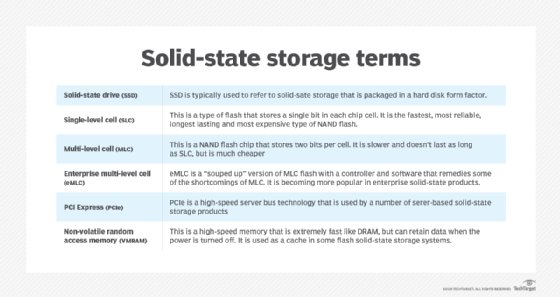solid-state drive (SSD) capacity (original) (raw)
Solid-state drive (SSD) capacity is the maximum amount of data that can be stored on a solid-state drive. Capacity can refer to an individual drive, all-flash array (AFA) or all-flash storage system, such as a hyper-converged infrastructure appliance or cluster of rackmount storage nodes. SSD capacity is typically measured in gigabytes or terabytes, although it might be measured in petabytes when referring to an entire storage system.
Capacity is one of the key storage metrics that decision-makers look for when evaluating flash-based storage for their organizations. Storage vendors often use one or more of the following categories to describe a storage system's capacity:
- Raw capacity is the actual amount of physical solid-state memory visible to the host system and available to store data.
- Usable capacity is the amount of physical memory that's available for storing data after subtracting the capacity that has been overprovisioned to support storage-related operations. How usable storage capacity is calculated and reported depends on the storage vendor. For example, the usable storage calculations for an AFA might take into account the space used for spares, cache, parity and system overhead.
- Effective capacity is the amount of data that can be stored on the drive when techniques such as compression and deduplication are applied to the data. The exact amount of data reduction depends on the algorithms and other technologies used by the manufacturer to process the data. Effective capacity commonly exceeds raw capacity, often by a significant amount.
How is SSD storage capacity determined?
An SSD's capacity is determined by the number of NAND chips per drive, the number of data cells on each chip and the number of bits per cell. The number of chips depends on the SSD's form factor, the types of chips used and how many chips the manufacturer chooses to add to the device -- within practical limits. An SSD might include chips on both sides of the circuit board or just mounted on one side.
The number of data cells per chip depends on the size of the cells and the underlying storage architecture. The smaller the cells, the more of them that can be squeezed onto a drive, resulting in greater capacity. However, smaller cells can also impact performance and shorten the drive's life span.
In addition, storage vendors employ either a planar or 3D architecture. With planar NAND, which is the traditional approach, all data cells exist on a single plane, providing a two-dimensional cellular structure for storing the bits. However, many vendors have moved to a 3D NAND architecture in which the cells are stacked across multiple layers, making it possible to increase the number of cells per chip without needing to make the cells too small.
An SSD's capacity is also determined by the number of bits per cell. Today's SSDs generally contain between 1 and 4 bits per cell:
- A single-level cell (SLC) flash SSD contains 1 bit per cell.
- A multi-level cell (MLC) flash SSD contains 2 bits per cell.
- A triple-level cell (TLC) flash SSD contains 3 bits per cell.
- A quad-level cell (QLC) flash SSD contains 4 bits per cell.

A solid-state drive's capacity is also determined by the number of bits per cell.
The more bits per cell, the more data each chip can hold and the cheaper the per-gigabyte cost for storage. For this reason, storage vendors are also working on penta-level cell (PLC) flash drives that contain 5 bits per cell, although it's still too soon to tell how successful this effort will be. Unfortunately, squeezing in more bits per cell can also impact performance and shorten the drive's life span, just like shrinking the cells.
In general, organizations looking for SSDs that can deliver top performance and a long life span have tended to stick to the SLC side of the scale. That said, SSD vendors have made significant advancements in NAND flash technology, offering enterprise TLC drives that can deliver the capacity and performance needed to support enterprise workloads, while still promising a decent life span. More recently, QLC drives have been making inroads into the enterprise SSD market, especially for supporting read-intensive workloads. Even so, SLC drives still remain the safest bet, although they come at the highest cost.
See also: how to get the best SSD performance, mSATA SSD, M.2 SSD, SSD vs. SSHD vs. HDD, SSD form factor, SSD write cycle, four causes of SSD failure and how to deal with them, and solid-state storage garbage collection.
This was last updated in April 2022
Continue Reading About solid-state drive (SSD) capacity
- Four common SSD form factors and where they work best
- Flash memory standards and interfaces every IT admin should know
- Flash memory guide to architecture, types and products
- Performance, reliability tradeoffs with SLC vs. MLC and more
- The future of flash memory promises unprecedented speed, capacity
 SSD vs. HDD: Key differences and when to use each
SSD vs. HDD: Key differences and when to use each  By: Robert Sheldon
By: Robert Sheldon  SSD write cycle
SSD write cycle  By: Carol Sliwa
By: Carol Sliwa  Explore benefits, tradeoffs with SLC vs. MLC vs. TLC and more
Explore benefits, tradeoffs with SLC vs. MLC vs. TLC and more  Flash memory guide to architecture, types and products
Flash memory guide to architecture, types and products  By: Stephen Bigelow
By: Stephen Bigelow